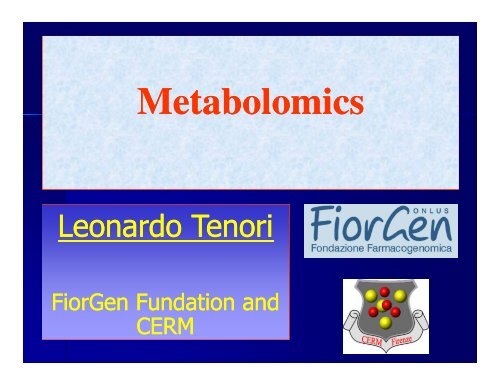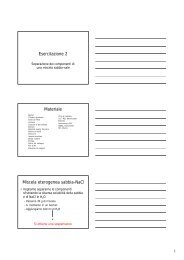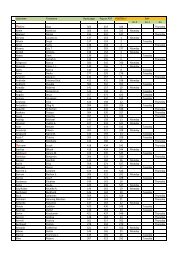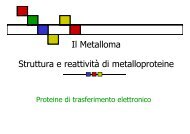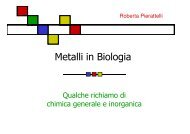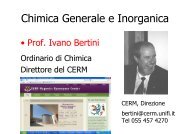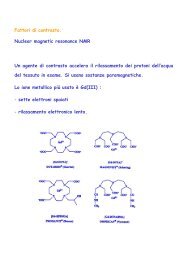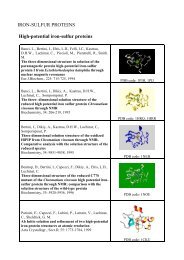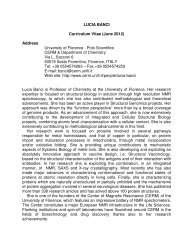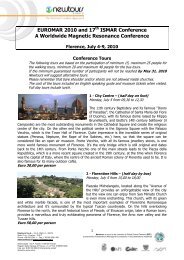Metabolomics - CERM
Metabolomics - CERM
Metabolomics - CERM
Create successful ePaper yourself
Turn your PDF publications into a flip-book with our unique Google optimized e-Paper software.
<strong>Metabolomics</strong><br />
Leonardo Tenori<br />
FiorGen Fundation and<br />
<strong>CERM</strong>
Systems Biology<br />
and the rise of the “-omics”<br />
Omics technologies such as genomics and high-throughput DNA sequencing were introduced in parallel to the<br />
Human Genome Project since 1990s. According to one etymological analysis, the suffix 'ome' is derived from the<br />
Sanskrit OM ("completeness and fullness") (Lederberg and McCray, 2001). Omics technologies and various<br />
neologisms that define their application contexts, however, are more than a simple play on words. They substantially<br />
transformed both the throughput and the design of scientific experiments. The omics technologies allow the<br />
generation of copious amounts of data at multiple levels of biology from gene sequence and expression to protein<br />
and metabolite patterns underlying variability in cellular networks and function of whole organ systems (Nicholson<br />
and Lindon, 2008; Wilke et al., 2008)<br />
Genomics<br />
Study of genes<br />
Epigenomics<br />
The study of the complete set of epigenetic (DNA methylation)<br />
modifications on the genetic material of a cell, known as the<br />
epigenome<br />
Transcriptomics<br />
All the mRNA in a cell/tissue/organism<br />
Proteomics<br />
All the proteins in a cell/tissue/organism<br />
Metallomics<br />
comprehensive analysis of the entirety of metal and metalloid species<br />
within a cell or tissue type<br />
Metabonomics/<strong>Metabolomics</strong><br />
All the metabolites in a cell/tissue/organism
“La metabolomica è l’ultima nata tra le scienze omiche e ha lo scopo di studiare il<br />
metaboloma, che è l’insieme di tutti i metaboliti contenuti in un fluido biologico (o cellula<br />
o tessuto)”.<br />
Cos’è la Metabolomica<br />
Punti di forza: forza<br />
Genomics: the only -omics which is not context dependent<br />
<strong>Metabolomics</strong>: strong environmental influence<br />
L’insieme dei metaboliti rappresenta<br />
l’espressione<br />
l’espressione amplificata amplificata del<br />
genoma<br />
I metaboliti sono caratterizzati da<br />
elevata stabilità. stabilità Ciò permette<br />
una elevata precisione e<br />
riproducibilità delle misure<br />
L’analisi metabolomica scatta<br />
“un’istantanea<br />
un’istantanea” dello stato di<br />
salute o malattia di un soggetto
Genomics is “only” the<br />
start!<br />
Genomics:<br />
the complete blueprint of an individual. What do we need more?<br />
There are 6 million parts in a 747 plane. If someone shows you the<br />
blueprints of all of them one after the other, would you be able to tell how<br />
the plane looks like?<br />
Proteomics:<br />
“only” 30-40,000 proteins.<br />
However, millions of potential interactions that make an “individual”. And the<br />
analysis is still very difficult…<br />
<strong>Metabolomics</strong>:<br />
Only a few thousand metabolites.<br />
However, not negligible external variability.
Metabolomica:<br />
la nuova frontiera<br />
“Genomics and proteomics tell you what<br />
might happen, but metabolomics tells<br />
you what actually did happen”<br />
Bill Lasley - University of California, Davis<br />
“If you have a disease, it’s likely that<br />
your metabolism is going to be<br />
affected. The same is true if you get hit<br />
with a toxicant. To be honest, the<br />
diagnostic potential is staggering”<br />
Mark Viant - University of Birmingham
Since the late 1990s,<br />
such metabolomic<br />
studies have<br />
undergone an<br />
explosive explosive growth growth and and<br />
this trend is still<br />
continuing, with more<br />
than a thousand of<br />
papers published in<br />
2010!<br />
Entries in Pubmed<br />
1400<br />
1200<br />
1000<br />
800<br />
600<br />
400<br />
200<br />
Metabonom*<br />
Metabolom*<br />
0<br />
1998 2000 2002 2004 2006 2008 2010 2012<br />
Year
Metabonomics “…measurement of the dynamic multiparametric<br />
metabolic response of living systems to pathophysiological stimuli or<br />
genetic modification…” Nicholson et al., 1999<br />
What’s in a name?<br />
<strong>Metabolomics</strong> “...the complete set of metabolites/low-molecular-weight<br />
intermediates, which are context dependent, varying according to the<br />
physiology, developmental or pathological state of the cell, tissue,<br />
organ or organism…” Oliver 2002
Metabolomica<br />
Analisi del profilo (della della concentrazione di un<br />
particolare metabolita o di una specifica<br />
classe classe)<br />
Analisi dell’impronta (della della presenza e<br />
concentrazione di tutti i metaboliti<br />
evidenziati, sia pure non tutti noti, e dal<br />
confronto con impronte campione per<br />
evidenziare alterazioni dovute a malattie,<br />
esposizione a tossine, alterazioni genetiche<br />
o impatto ambientale)<br />
ambientale
Metabolomica:<br />
alcuni obiettivi<br />
Valutare eventuali correlazioni tra<br />
impronta metabolica e malattia<br />
(sarebbe sarebbe così così possibile possibile disporre disporre di di nuovi nuovi<br />
strumenti strumenti per per approfondire<br />
approfondire le le<br />
conoscenze<br />
conoscenze su su determinate<br />
determinate patologie)<br />
patologie
Metabolomica:<br />
alcuni obiettivi<br />
Cercare di capire se sia possibile diagnosticare<br />
e valutare lo stadio di avanzamento di una<br />
malattia<br />
(una una diagnosi diagnosi più più precoce precoce dei dei tumori tumori di di quella quella<br />
attualmente<br />
attualmente possibile, possibile, per per esempio, esempio,<br />
permetterebbe<br />
permetterebbe di di salvare salvare il il 30 30%% di di malati malati<br />
utilizzando utilizzando ii farmaci farmaci attualmente<br />
attualmente disponibili)<br />
disponibili
Metabolomica:<br />
alcuni obiettivi<br />
Scoprire nuovi biomarker<br />
(quelli quelli attuali attuali utilizzati utilizzati per per la la diagnosi diagnosi di di<br />
alcune alcune patologie patologie potrebbero potrebbero non non<br />
essere essere gli gli unici unici e/o e/o ii più più efficienti)<br />
efficienti
Metabolomica:<br />
alcuni obiettivi<br />
Studiare i metaboliti connessi a specifici<br />
pathway metabolici<br />
(sarebbe sarebbe possibile possibile definire definire dei dei nuovi nuovi<br />
bersagli bersagli per per farmaci farmaci futuri futuri ee valutare valutare<br />
l’impatto l’impatto di di quelli quelli attuali attuali permettendo<br />
permettendo<br />
una una personalizzazione personalizzazione avanzata avanzata della della<br />
terapia)<br />
terapia
The metabolome<br />
consists of what?<br />
Small organic molecules: amino acids, fatty acids,<br />
carbohydrates, vitamins, and lipids<br />
& some inorganic, elemental species<br />
Metabolome informatics resource:<br />
Metabolome informatics resource:<br />
Kyoto Encyclopedia of genes and genomes (kegg)<br />
http://www.genome.jp/kegg/compound<br />
The human metabolome project: metabolomics toolbox<br />
http://www.metabolomics.ca<br />
National Centre for Plants & Microbial <strong>Metabolomics</strong>:<br />
http://www.metabolomics.bbsrc.ac.uk
What is a<br />
Metabolite?<br />
Any organic molecule detectable in the<br />
body with a MW < 1000 Da<br />
Includes peptides, oligonucleotides,<br />
sugars, nucelosides, organic acids,<br />
ketones, aldehydes, amines, amino<br />
acids, lipids, steroids, alkaloids and<br />
drugs (xenobiotics)<br />
Includes human & microbial products<br />
Concentration > 1µM
C om p ound class N u m b er C om p ound cla ss N u m b er<br />
A cyl g lycin es 10 Indoles and indole derivatives 12<br />
A cyl p h osp h ates 10 In organic ions and gases 20<br />
A lcohol p h osp h ates 2 K eto acid s 8<br />
A lcohols an d p olyols 40 K eto nes 6<br />
A ld ehyd es 3 L eukotrienes 8<br />
A lkan es an d alkenes 10 M inerals and elem ents 40<br />
A m in o acid p h osp h ates 1 M iscellaneous 77<br />
A m in o acid s 114 N ucleosides 24<br />
A m in o alcoh ols 14 N ucleotid es 24<br />
A m in o k etones 14 P eptid es 21<br />
A rom atic acid s 22 P hosph olipids 2177<br />
B ile acid s 19 P olyam ines 11<br />
B iotin an d d erivatives 2 P olyphen ols 22<br />
C arb oh ydrates 35 P orphyrin s 6<br />
C arn itin es 22 P rostan oid s 23<br />
C atech olam in es an d d erivatives 21 P terins 14<br />
C ob alam in d erivates 4 P urines and purine d erivatives 11<br />
C oen zym e A d erivatives 1 P yridoxals and derivatives 7<br />
C yclin am in es 9 P yrim idines and pyrim idine derivatives 2<br />
D icarb oxylic acid s 17 Q uinones and derivatives 3<br />
F atty acid s 65 R etinoid s 11<br />
G lu coron id es 8 Sphingo lipid s 3<br />
G lycerolip id s 1070 Steroid s and steroid derivatives 109<br />
G lu ycolip id s 15 Sugar phosp hates 9<br />
H ydroxy acid s 129 T ricarboxylic acids 2
H 2N<br />
O<br />
O<br />
Glycine<br />
O<br />
Pyruvic acid<br />
OH<br />
HO<br />
H 2N<br />
OH<br />
HO<br />
O<br />
Esempio di metaboliti<br />
NH<br />
O<br />
H<br />
N<br />
Succinic acid<br />
O O<br />
Oxaloacetic acid<br />
Arginine<br />
N<br />
H<br />
Tryptophan<br />
O<br />
OH<br />
OH<br />
NH 2<br />
O<br />
O<br />
NH 2<br />
OH<br />
OH<br />
H 2N<br />
N<br />
N<br />
N<br />
N<br />
Acetyl CoA<br />
O<br />
HO OH<br />
Adenosine-5'-triphosphate<br />
O<br />
O<br />
O<br />
O<br />
P<br />
P<br />
OH<br />
P<br />
OH<br />
OH<br />
O<br />
O<br />
OH
Why 1 µM?<br />
Equals ~200 ng/mL<br />
Limit of detection by NMR<br />
Limit of facile isolation/separation by<br />
many analytical methods<br />
Excludes environmental pollutants<br />
Most disease indicators have<br />
concentrations >1 µM<br />
Need to draw the line somewhere
<strong>Metabolomics</strong><br />
Generate metabolic “signatures”<br />
Monitor/measure metabolite flux<br />
Monitor enzyme/pathway kinetics<br />
Assess/identify phenotypes<br />
Monitor gene/environment interactions<br />
Track effects from toxins/drugs/surgery<br />
Monitor consequences from gene KOs<br />
Identify functions of unknown genes
Medical <strong>Metabolomics</strong><br />
Generate metabolic “signatures” for disease<br />
states or host responses<br />
Obtain a more “holistic” view of metabolism<br />
(and treatment)<br />
Accelerate assessment & diagnosis<br />
More rapidly and accurately (and cheaply)<br />
assess/identify disease phenotypes<br />
Monitor gene/environment interactions<br />
Rapidly track effects from drugs/surgery
Metabolomica<br />
Medicina:<br />
Pochi metaboliti di<br />
riferimento per ogni<br />
specifica patologia<br />
Metabolomica:<br />
Quadro d’insieme dei<br />
metaboliti
Traditional Metabolite<br />
Analysis<br />
HPLC, GC, CE, MS
Problems with<br />
Traditional Methods<br />
Requires separation followed by<br />
identification (coupled methodology)<br />
Requires optimization of separation<br />
conditions each time<br />
Often requires multiple separations<br />
Slow (up to 72 hours per sample)<br />
Manually intensive (constant supervision,<br />
high skill, tedious)
What’s the<br />
Difference Between<br />
<strong>Metabolomics</strong> and<br />
Traditional Clinical<br />
Chemistry?<br />
Throughput<br />
(more metabolites, greater<br />
accuracy, higher speed)
New <strong>Metabolomics</strong><br />
Approaches<br />
+<br />
Impronta digitale metabolica
Advantages<br />
Measure multiple (10’s to 100’s) of<br />
metabolites at once – no separation!!<br />
Allows metabolic profiles or “fingerprints” to<br />
be generated<br />
Mostly automated, relatively little sample<br />
preparation or derivitization<br />
Can be quantitative (esp. NMR)<br />
Analysis & results in < 60 s
NMR versus MS<br />
• Quantitative, very<br />
fast<br />
• Requires no work<br />
up or separation<br />
• Allows analysis of<br />
300+ cmpds at<br />
once<br />
• Not sensitive<br />
• Quite fast<br />
• Very sensitive<br />
• Allows analysis or<br />
ID of 3000+ cmpds<br />
at once<br />
• Not quantitative<br />
• Requires work-up
2 Routes to <strong>Metabolomics</strong><br />
Two approaches:<br />
• Identify as many metabolites as possible<br />
• Use the whole spectrum as a fingerprint (statistics)<br />
ppm<br />
hippurate urea<br />
fumarate<br />
7<br />
6<br />
5<br />
ppm<br />
Quantitative<br />
methods<br />
hippurate<br />
allantoin<br />
creatinine taurine<br />
water<br />
4<br />
7<br />
TMAO<br />
3<br />
citrate<br />
2<br />
6<br />
creatinine<br />
1<br />
5<br />
2-oxoglutarate<br />
succinate<br />
4<br />
3<br />
2<br />
1<br />
Chemometric methods<br />
(fingerprinting and pattern recognition)<br />
25<br />
PC2<br />
20<br />
15<br />
10<br />
5<br />
0<br />
-5<br />
-10<br />
-15<br />
-20<br />
-25<br />
-30 -20 -10 0<br />
PC1<br />
10
• Identifies compounds<br />
• Quantifies compds<br />
Quantitative vs.<br />
Chemometric<br />
• Concentration range of<br />
1 µM to 1 M<br />
• Handles wide range of<br />
samples/conditions<br />
• Allows identification of<br />
diagnostic patterns<br />
• Limited by DB size<br />
• No compound ID<br />
• No compound conc.<br />
• No compound<br />
concentration range<br />
• Requires strict sample<br />
uniformity<br />
• Allows identification<br />
of diagnostic patterns<br />
• Limited by training set
Benefits of analyzing the<br />
metabolome<br />
Number of metabolites lower than number of genes and proteins in<br />
a cell - sample complexity reduced<br />
Although concentration of enzyme & metabolic flux may not<br />
significantly change during a biochemical reaction, concentration<br />
of metabolites can change significantly<br />
Reflect more accurately functional level of a cell<br />
Metabolic fluxes regulated not only by gene expression but also by<br />
environmental stresses - hence worth measuring downstream<br />
products (i.e. metabolites)<br />
Estimated that metabolomic expts are 2x to 3x less expensive than<br />
proteomic & transcriptomic expts
Challenges when<br />
analyzing metabolomes<br />
Metabolomes extend over 7 to 9<br />
order of magnitudes in<br />
concentration (picomoles to<br />
millimoles)<br />
Currently not possible to analyze all<br />
metabolites in a single analysis<br />
Several analytical strategies (MS,<br />
NMR in combination with<br />
chromatographic separations,<br />
whole cell analysis)<br />
Requires high throughput
Advantages:<br />
Use of NMR in<br />
Non-destructive, non-biased<br />
Easily quantifiable<br />
Requires little or no separation<br />
metabolomics studies<br />
Permits identification of novel compounds<br />
Does not require chemical derivatization<br />
Particularly amenable to cmpds less tractable to GC-MS<br />
or LC-MS (sugars, amines, volatile ketones, &<br />
relatively non-reactive compounds)<br />
Ref. Trends in analytical chemistry (2008) Vol 27, pp.228-237
Disavantage of the NMR<br />
approach<br />
Relatively insensitive technique<br />
Lower limit of detection 1-5 µM<br />
Usually large sample size (500 µL)
Raccolta e<br />
stoccaggio<br />
dei campioni<br />
Processo Sperimentale<br />
Preparazione<br />
dei campioni<br />
Analisi<br />
Statistica<br />
Impronta<br />
Misure<br />
NMR<br />
Profilo<br />
Assegnamento<br />
dei segnali<br />
Elaborazione<br />
degli spettri<br />
Database di<br />
composti di<br />
riferimento
NMR Experiment<br />
A current through (green)<br />
generates a strong magnetic field<br />
polarizes the nuclei in the sample<br />
material (red).<br />
It is surrounded by the r.f. coil (black)<br />
delivers the computer generated r.f.<br />
tunes that initiate the nuclear<br />
quantum dance.<br />
At some point in time, the switch is<br />
turned and now the dance is recorded<br />
through the voltage it induces.<br />
the NMR signal, in the r.f. coil.<br />
The signals Fourier transform (FT) shows<br />
"lines" for different nuclei in different<br />
electronic environments.
NMR<br />
A typical 950-MHz H NMR spectrum of urine showing the<br />
degree of spectral complexity
Profilo 1 H NMR di urina umana
Profilo 1 H NMR di urina umana
Profilo 1 H NMR di urina umana
Profilo di siero umano<br />
Proteins + Lipids + Small molecules<br />
Lipids + Small molecules<br />
Lipids + Proteins<br />
Lipids
serum<br />
urine<br />
saliva<br />
fecal extract
Data analysis - approach<br />
Classify NMR spectrum based on its<br />
inherent patterns of peaks<br />
Identify spectral features responsible<br />
for the classification (according to<br />
physiological or pathological status)<br />
NMR spectral data processing<br />
Prepare NMR data for multivariate<br />
modeling:<br />
Spectral binning: spectra divided<br />
into regions whose areas are<br />
summed to extract peak intensities<br />
Results in a data matrix:<br />
Rows = samples/observations<br />
Columns= variables (for example,<br />
normalized peak intensities of<br />
defined bins)
Data analysis and<br />
interpretation<br />
Data collected represented in a matrix<br />
Chemometric Approach<br />
Principle Component Analysis (PCA)<br />
Soft Independent Modeling of Class Analogy (SIMCA)<br />
Partial Least-Squares aka Projections to Latent Structures (PLS)<br />
Orthogonal PLS (OPLS)<br />
Targeted Profiling
PCA<br />
Unsupervised<br />
Multivariate analysis based on projection methods<br />
Main tool used in chemometrics<br />
Extract and display the systematic variation in the data<br />
Each Principle Component (PC) is a linear combination of the<br />
original data parameters<br />
Each successive PC explains the maximum amount of variance<br />
possible, not accounted for by the previous PCs<br />
PCs Orthogonal to each other<br />
Conversion of original data leads to two matrices, known as<br />
scores and loadings<br />
The scores(T) represent a low-dimensional plane that closely<br />
approximates X. Linear combinations of the original<br />
variables. Each point represents a single sample spectrum.<br />
A loading plot/scatter plot(P) shows the influence (weight) of the<br />
individual X-variables in the model. Each point represents a<br />
different spectral intensity.<br />
The part of X that is not explained by the model forms the<br />
residuals(E)<br />
X = TP T = t 1p 1 T + t 2p 2 T + ... + E
PCA Plot Nomenclature<br />
• PCA Generate 2<br />
kinds of plots, the<br />
scores plot and the<br />
loadings plot<br />
• Scores plot (on<br />
right) plots the data<br />
using the main<br />
principal<br />
components<br />
original<br />
data<br />
Z = X W<br />
scores loading
PCA Loadings Plot<br />
• Loadings plot shows<br />
how much each of the<br />
variables<br />
(metabolites)<br />
contributed to the<br />
different principal<br />
components<br />
• Variables at the<br />
extreme corners<br />
contribute most to the<br />
scores plot separation
PCA Details/Advice<br />
In some cases PCA will not succeed in<br />
identifying any clear clusters or obvious<br />
groupings no matter how many components<br />
are used. If this is the case, it is wise to<br />
accept the result and assume that the<br />
presumptive classes or groups cannot be<br />
distinguished with PCA<br />
As a general rule, if a PCA analysis fails to<br />
achieve even a modest separation of classes,<br />
then it is probably better to use other<br />
statistical techniques to try to separate them
SIMCA<br />
Supervised learning method<br />
based on PCA<br />
Construct a seperate PCA<br />
model for each known class<br />
of observations<br />
PCA models used to assign the<br />
class belonging to observations<br />
of unknown class origin<br />
Recommended for use in one class<br />
case or for classification if no<br />
interpretation is needed<br />
CLASS SPECIFIC STUDIES<br />
One-class problem: Only disease observations<br />
define a class; control samples are too<br />
heterogeneous, for example, due to other<br />
variations caused by diseases, gender, age, diet,<br />
lifestyle, etc.<br />
Two-class problem: Disease and control<br />
observations define two seperate classes
PLS<br />
Supervised learning method.<br />
Recommended for two-class cases instead of using<br />
SIMCA.<br />
Principles that of PCA. But in PLS, a second piece<br />
of information is used, namely, the labeled set<br />
of class identities.<br />
Two data tables considered namely X (input data<br />
from samples) and Y (containing qualitative<br />
values, such as class belonging, treatment of<br />
samples)<br />
The quantitive relationship between the two tables<br />
is sought.<br />
X = TP T + E<br />
Y = TC T + E<br />
The PLS algorithm maximizes the covariance<br />
between the X variables and the Y variables<br />
PLS models negatively affected by systematic<br />
variation in the X matrix not related to the Y<br />
matrix (not part of the joint correlation<br />
structure between X-Y.
OPLS<br />
OPLS method is a recent modification of the PLS method to help overcome pitfalls<br />
Main idea to seperate systematic variation in X into two parts, one linearly related to Y and one unrelated<br />
(orthogonal).<br />
T T<br />
Comprises two modeled variations, the Y-predictive (T P ) and the Y-orthogonal (ToP ) compononents.<br />
p p<br />
o<br />
Only Y-predictive variation used for modeling of Y.<br />
T T<br />
X = T P + ToP + E<br />
p p o<br />
T<br />
Y = T C + F<br />
p p<br />
E and F are the residual matrices of X and Y<br />
OPLS-DA compared to PLS-DA
Remarks on pattern<br />
classification<br />
Intent in using these classification techniques not to identify<br />
specific compound<br />
Classify in specific categories, conditions or disease status<br />
Traditional clinical chemistry depended on identifying and<br />
quantifying specific compounds<br />
Chemometric profiling interested in looking at all<br />
metabolites at once and making a phenotypic<br />
classification of diagnosis
Targeted profiling<br />
Targeted metabolomic profiling is fundamentally different than<br />
most chemometric approaches.<br />
In targeted metabolomic profiling the compounds in a given<br />
biofluid or tissue extract identified and quantified by comparing<br />
the spectrum of interest to a library of reference spectra of<br />
pure compounds.<br />
Key advantage: Does not require collection of identical sets =<br />
More amenable to human studies or studies that require less<br />
day-to-day monitoring.<br />
Disadvantage: Relatively limited size of most current spectral<br />
libraries = bias metabolite identification and interpretation.<br />
A growing trend towards combining the best features of both<br />
chemometric and targeted methods.
Databases<br />
Large amount of data<br />
Need for databases that can be easily searched<br />
Better databases will help in combining<br />
chemometric and targeted profiling methods<br />
Newly emerging databases<br />
HMDB good model for other databases<br />
Challenge of standardisation
Databases
Metabolomica:<br />
Fattori di variabilità<br />
Sesso<br />
Età<br />
Dieta<br />
Dieta<br />
Ritmi fisiologici<br />
Genotipo<br />
Stress<br />
Patologie
Effetto della dieta<br />
Trimetilammina N-ossido<br />
Consumo di pesce<br />
NON Consumo di pesce<br />
Consumo di chewing-gum, caramelle etc..<br />
Mannitolo<br />
4 .00 3.90 3.80 3.7 0 3.60
Ind 1<br />
Ind 2<br />
Effetto del profilo individuale<br />
10.00 7.50 5.00 2.50 ppm<br />
62
Effetto delle patologie<br />
Campioni di saliva da individui sani e da individui affetti da periodontite cronica
Our interest in metabolomics<br />
Metabolic signature of individuals<br />
Metabolic phenotype<br />
Metabolic signature of diseases<br />
• Celiac disease<br />
• tumor → metastasis (breast, colorectal)<br />
• cardiovascular risk<br />
• diabetes<br />
• pulmonary diseases<br />
• …<br />
Metabolites and biobank samples<br />
• Sensitive reporters of stability<br />
• Assess sample preparation and preanalytical procedures<br />
• …
METabolomic REFerence<br />
The METREF project<br />
Looking first at urine of healthy individuals, and developing a<br />
feeling for the intraindividual vs. interindividual variations<br />
Why?<br />
• Training<br />
• Urine samples are easy to collect<br />
• Large number of samples<br />
• Potential intrinsic value of the information
METabolomic REFerence<br />
Experimental scheme:<br />
• 22 Individuals, 11 Males & 11 Females<br />
• ≥40 urine samples each, on a period of 2-3 months<br />
• First in the morning preprandial<br />
• Collection suspended in case of illness; otherwise no restrictions<br />
• Data recording:<br />
Diet<br />
Drugs<br />
Lifestyle, general habits<br />
Smoker / No Smoker<br />
• NMR analysis: 1D 1 H spectra
Ind 1<br />
Ind 2<br />
METabolomic REFerence<br />
Getting a first feeling…<br />
We believe the human<br />
eye is very sensitive to<br />
differences in patterns<br />
Visual inspection suggests that it should be interesting to look for individual<br />
fingerprints by statistical analysis
METabolomic REFerence<br />
Convex hulls of 22 donors in the three most significant PCA PCA-CA CA dimensions<br />
PCA for data<br />
reduction<br />
CA for obtain<br />
well separated<br />
clusters<br />
KNN for<br />
classification<br />
99% accuracy<br />
in montecarlo<br />
cross validation<br />
“natural” gender discrimination<br />
MALE<br />
FEMALE<br />
Assfalg, Bertini, Colangiuli, Luchinat, Schäfer, Schütz, Spraul, PNAS PNAS, , 2008 2008, , 105, 1420 1420-4
METabolomic REFerence<br />
Dendrogram of the 22 donors on the 21 21-dimensional dimensional PCA-CA PCA CA subspace<br />
Assfalg, Bertini, Colangiuli, Luchinat, Schäfer, Schütz, Spraul, PNAS PNAS, , 2008 2008, , 105, 1420 1420-4
METabolomic REFerence<br />
Gut microflora related metabolites<br />
Concentrations of 12 selected metabolites for each donor. Absolute<br />
creatinine concentration (Crea) and relative metabolite<br />
concentrations (relative to creatinine)
METabolomic REFerence<br />
An individual metabolic fingerprint exist!<br />
But it is hidden inside the daily noise<br />
Assfalg, Bertini, Colangiuli, Luchinat, Schäfer, Schütz, Spraul, PNAS PNAS, , 2008 2008, , 105,<br />
1420-4<br />
1420
METabolomic REFerence 2<br />
Why Healthy Individuals Again?<br />
• Expanding the dataset<br />
• Trying to learn more about relevance of genetic vs lifestyle contributions<br />
• Check the constancy of metabolic phenotypes over time
METabolomic REFerence 2<br />
Experimental Scheme (2 years later)<br />
• 20 Individuals, 9 Male & 11 Females<br />
• 11 Individuals (6 M + 5 F) already in the first screening<br />
• 40 samples/each on a period of 2-3 months<br />
• First in the morning preprandial<br />
• Collection suspended in case of illness<br />
• Data recording:<br />
Diet<br />
Drugs<br />
Life style<br />
Smoker / No Smoker<br />
• NMR analysis: 1D 1 H spectra
METREF 1,2,3<br />
11<br />
7 4 22<br />
t 20 7 4<br />
4<br />
4<br />
father<br />
& son<br />
5 22<br />
twins<br />
MetRef1<br />
2005<br />
MetRef2<br />
2007<br />
MetRef3<br />
2008
METabolomic REFerence 2<br />
2005 collection 2007 collection<br />
AD<br />
AF<br />
AG<br />
AH<br />
AI<br />
AO<br />
AP<br />
AR<br />
AS<br />
AT<br />
AU<br />
AW<br />
AX<br />
AZ<br />
BC<br />
BD<br />
BE<br />
BF<br />
BG<br />
BH<br />
BI<br />
BK<br />
99.905%<br />
100.000%<br />
100.000%<br />
99.922%<br />
99.760%<br />
97.500%<br />
97.500%<br />
100.000%<br />
100.000%<br />
99.995%<br />
100.000%<br />
100.000%<br />
100.000%<br />
100.000%<br />
99.998%<br />
100.000%<br />
100.000%<br />
100.000%<br />
99.933%<br />
100.000%<br />
100.000%<br />
99.470%<br />
AI<br />
AO<br />
AR<br />
AS<br />
AU<br />
AW<br />
BC<br />
BF<br />
BG<br />
BH<br />
BI<br />
BQ<br />
BS<br />
BT<br />
BU<br />
BV<br />
BX<br />
BZ<br />
TA<br />
TB<br />
100.000<br />
100.000% %<br />
99.995%<br />
99.941%<br />
100.000%<br />
99.998%<br />
99.705%<br />
99.629%<br />
100.000%<br />
100.000%<br />
98.462%<br />
99.998%<br />
100.000%<br />
99.983%<br />
96.647%<br />
99.998%<br />
99.998%<br />
100.000%<br />
98.450%<br />
98.235%<br />
PCA-CA-KNN classification results<br />
Bernini, P.; Bertini, I.; Luchinat, C.; Nepi, S.; Saccenti, E.; Schäfer, H.; Schütz, B.; Spraul,<br />
M.; Tenori, L. Individual human phenotypes in metabolic space and time, J. Prot. Res. 2009
METabolomic REFerence<br />
genes<br />
lifestyle etc.<br />
• Il metabotipo consiste di una parte variabile (ambiente) e di una parte<br />
invariabile (genetica+ambiente)<br />
• La parte invariante rimane inalterata per almeno 2/3 anni<br />
• La scoperta del fingerprint metabolico individuale ha un grande<br />
potenziale per studi biomedici<br />
Bernini, P.; Bertini, I.; Luchinat, C.; Nepi, S.; Saccenti, E.; Schäfer, H.; Schütz, B.; Spraul, M.; Tenori, L.<br />
Individual human phenotypes in metabolic space and time, J. Prot. Res. 2009
Un “salto” metabolico<br />
Evoluzione del profilo metabolico di un individuo<br />
nell’arco di tre anni<br />
Hippurate<br />
MetRef1<br />
MetRef2<br />
MetRef3
Celiac Disease <strong>Metabolomics</strong><br />
What is Celiac Disease?<br />
• Celiac Disease (CD), or sprout, is a permanent intolerance to gluten<br />
• Gluten is a proteic complex formed by gliadin and glutenin<br />
• Gluten is found in wheat, rye and barley and others<br />
• Gliadin and glutenin comprise about 80% of the protein contained in wheat<br />
seeds.<br />
• Gluten is present in bread, pasta, pizza, biscuits…<br />
• Gluten is one of the most used alimentary additives<br />
The ONLY therapy is a<br />
totally gluten-free diet<br />
Aim: define the metabolome of celiac disease; obtain hints on its biochemistry
Celiac Disease <strong>Metabolomics</strong><br />
Experimental scheme:<br />
• Study subjects: 34<br />
• Control subjects: 34<br />
• Samples: Serum and Urine<br />
NMR spectra acquired:<br />
• 1D Noesy (standard 1D 1H spectra) for serum and urine samples<br />
• CPMG: to remove signals due to macromolecules (on serum samples)<br />
• @ a Bruker 600 MHz<br />
Statistical<br />
Analysis<br />
Projection to Latent Structures (PLS) to reduce data dimension Optimal number of<br />
components obtained by minimizing the Cross-Validated (CV) error<br />
Canonical Analysis (CA) to obtain two well separated clusters<br />
Support Vector Machines (SVM) for classification
Celiac Disease <strong>Metabolomics</strong><br />
Results<br />
CPMG spectra Serum<br />
Accuracy: 83.4%<br />
Sensivity: 83.4%<br />
Specifity: 83.4%<br />
NOESY spectra Serum<br />
Accuracy: 78.9%<br />
Sensivity: 74.0%<br />
Specifity: 82.8%<br />
NOESY spectra Urine<br />
Accuracy: 69.3%<br />
Sensivity: 73.9%<br />
Specifity: 63.9%
Celiac Disease <strong>Metabolomics</strong><br />
Note: both subjects are<br />
asymptomatic!<br />
Clusterization of serum spectra of celiac and healthy subjects<br />
Bertini, I.; Calabrò, A.; De Carli, V.; Luchinat, C.; Nepi, S.; Porfirio, B.; Renzi, D.; Saccenti, E.;<br />
Tenori, L. The metabonomic signature of celiac disease, J. Proteome Res. 2009, 8(1), 170
Celiac Disease <strong>Metabolomics</strong><br />
Significantly different metabolites in<br />
serum (p
Celiac Disease <strong>Metabolomics</strong><br />
Celiac disease often associated with fatigue:<br />
Why ?<br />
Increased glucose, decreased pyruvate, lactate:<br />
Impaired glycolysis, impaired energy production<br />
Lipid beta beta-oxidation oxidation + use of ketonic bodies:<br />
Alternate less efficient energy production
Celiac Disease <strong>Metabolomics</strong><br />
Follow-up analysis<br />
Samples at 3, 6, 9, 12 months from diagnosis<br />
Serum and urines<br />
Metabolite profiling<br />
Patter recognition<br />
Using CPMG sera, all but one samples after 12<br />
months on a gluten-free diet are classified as<br />
normal!
Celiac Disease <strong>Metabolomics</strong><br />
Clusterization of Celiac and Healthy subject serum spectra<br />
Bertini, I.; Calabrò, A.; De Carli, V.; Luchinat, C.; Nepi, S.; Porfirio, B.; Renzi, D.; Saccenti, E.;<br />
Tenori, L. The metabonomic signature of celiac disease, J. Proteome Res. 2009, 8(1), 170
Celiac Disease <strong>Metabolomics</strong><br />
Clusterization of Celiac and Healthy subject serum spectra<br />
and corresponding Follow-up<br />
Bertini, I.; Calabrò, A.; De Carli, V.; Luchinat, C.; Nepi, S.; Porfirio, B.; Renzi, D.; Saccenti, E.;<br />
Tenori, L. The metabonomic signature of celiac disease, J. Proteome Res. 2009, 8(1), 170
Potential celiac disease<br />
Subjects: 134<br />
Celiacs: 59 (9 male, 50 female, age 40,2 ± 14,9)<br />
Potential Celiacs: 25 (5 male, 20 female, age 34,2 ± 13,1)<br />
Healthy: 50 (18 male, 32 female, age 36,1 ± 13,9)<br />
Aim: define the metabolome of potential<br />
celiacs subjects<br />
The term potential CD patients has been proposed for those subjects who do not<br />
have, and have never had, a jejunal biopsy consistent with clear CD, and yet have<br />
immunological abnormalities similar to those found in celiac patients.
Potential Celiac Disease<br />
Celiacs Celiacs Vs Vs Healthy<br />
Serum Serum Serum CPMG<br />
CPMG<br />
• Accuracy: 82.3 82.3 %<br />
%<br />
• Sensivity: 82.3 82.3 %<br />
%<br />
• Specifity82.9 82.9 % %<br />
%<br />
Serum Serum Serum Serum Serum Noesy<br />
Noesy<br />
• Accuracy : 74.4 74.4 % %<br />
%<br />
• Sensivity: 77.6 77.6 77.6 %<br />
%<br />
• Specifity : 70.1 70.1 %<br />
%<br />
Urine Urine Noesy<br />
Noesy<br />
• Accuracy : 69.4 69.4 %<br />
%<br />
• Sensivity : 73.3 73.3 73.3 % %<br />
%<br />
• Specifity: 64.1 64.1 %<br />
%<br />
Celiacs Celiacs Vs Vs Potential Potential Celiacs<br />
Celiacs<br />
Serum Serum CPMG<br />
CPMG<br />
• Accuracy : 63.7 63.7 %<br />
%<br />
• Sensivity : 81.2 81.2 %<br />
%<br />
• Specifity : 19.7 19.7 %<br />
%<br />
Serum Serum Noesy Noesy Noesy Noesy<br />
Noesy Noesy Noesy<br />
. . Accuracy : 64.9 64.9 %<br />
%<br />
• Sensivity : 81.8 81.8 81.8 % %<br />
%<br />
• Specifity : 24.7 24.7 %<br />
%<br />
Urine Urine Noesy<br />
Noesy<br />
• Accuratezza : 59.9 59.9 %<br />
%<br />
• Sensivity : 79.0 79.0 %<br />
%<br />
• Specifity: 11.3 11.3 11.3 %<br />
%
Celiachia Potenziale<br />
Celiaci – Sani –<br />
Croci: predizione dei Celiaci Potenziali<br />
Celiaci Potenziali: soggetti con anticorpi positivi<br />
alla gliadina ma senza presenza di danno<br />
intestinale. NON sono celiaci e NON vengono<br />
messi a dieta<br />
Esiste una impronta metabolica<br />
della celiachia<br />
Queste alterazioni sono presenti<br />
anche nei celicaci potenziali:<br />
esse precedono il danno<br />
intestinale<br />
La celiachia potenziale è molto<br />
simile da un punto di vista<br />
metabolico alla celiachia. Molti<br />
metaboliti che differenziano I<br />
controlli e celiaci sono alterati<br />
anche nei celiaci potenziali. I<br />
nostri risultati suggeriscono l’uso<br />
di dieta priva di glurine anche<br />
nei celiaci potenziali<br />
Bernini P, Bertini I, Calabrò A, la Marca G, Lami G, Luchinat C, Renzi D, Tenori L. Are patients with<br />
potential celiac disease really potential? The answer of metabonomics. J. Proteome Res. 2010
Spettro NMR di olio di oliva<br />
Prime esperienze con olio acquisite alcuni anni fa (Prof. Luchinat)<br />
L.Mannina, C.Luchinat, M.Patumi, M.C.Emanuele, E.Rossi. A.L.Segre,<br />
"Concentration dependence of 13C NMR spectra of triglycerides: implications for the<br />
NMR anlysisis of olive oils",<br />
Magnetic Resonance in Chemistry (2000), 38, 886-890.<br />
L.Mannina, C.Luchinat, M.C.Emanuele, A.L.Segre,<br />
"Acyl positional distribution of glycerol tri-esters in vegetable oils: a 13C NMR study",<br />
Chemistry and Physics of Lipids, (1999), 103, 47-55.
ACIDO LINOLENICO REGIONE DEI METILI<br />
( 1H) H)<br />
β SITOSTEROLO<br />
OLIO DI OLIVA<br />
EXTRAVERGINE<br />
OLIO DI OLIVA<br />
OLIO DI GIRASOLE<br />
OLIO DI MAIS<br />
OLIO DI SOIA<br />
OLIO DI ARACHIDI
ATTRIBUTI SENSORIALI<br />
Olio amaro<br />
Olio avvinato<br />
Cattiva separazione<br />
dalle acque di<br />
vegetazione<br />
Olio pungente<br />
Olio fruttato
PRODOTTI DI OSSIDAZIONE QUASI ASSENTI IN<br />
UN OLIO BUONO<br />
OLIO EXTRAVERGINE<br />
OLIO RANCIDO
CARATTERIZZAZIONE GEOGRAFICA ( 1 H)<br />
Olio Siciliano Olio Umbro
CARATTERIZZAZIONE<br />
GEOGRAFICA ( 1 H):<br />
OLI TOSCANI<br />
TCA LDA<br />
Seggiano Lucca Arezzo<br />
Root 2<br />
10<br />
-8<br />
-15 -10 -5 0 5 10 15<br />
L. Mannina, M.Patumi, N.Proietti, A.L. Segre, Italian Journal of Food Science. (2001), 13, 53-64<br />
8<br />
6<br />
4<br />
2<br />
0<br />
-2<br />
-4<br />
-6<br />
Root 1<br />
S<br />
AR<br />
A
CARATTERIZZAZIONE<br />
GEOGRAFICA ( 1 H):<br />
OLI DEL CENTRO-NORD<br />
LDA<br />
L.Mannina, M.Patumi, N.Proietti, D.Bassi, A.L.Segre, Journal of Agriculture and Food Chemistry, (2001), 49, 2687-<br />
2696
Metabolomica del latte<br />
Recente interesse per<br />
l’applicazione della metabolomica<br />
all’analisi del latte e dei suoi<br />
derivati
*Lattosio<br />
Spettro 1 H NMR di latte<br />
Lecitina<br />
Creatina<br />
Glicerolo<br />
Acidi grassi<br />
insaturi<br />
*<br />
Citrato<br />
Acidi<br />
grassi
Spettro 1 H NMR di marche diverse<br />
Non si osservano differenze negli<br />
spettri di latte fresco intero tra marche<br />
diverse.<br />
Il Granarolo parzialmente scremato<br />
presenta picchi meno intensi nella<br />
zona degli acidi grassi (frecce).<br />
Maremma<br />
Mukki<br />
Granarolo
Spettro 1 H NMR di latte scremato<br />
Lo spetto di latte scremato non<br />
presenta i picchi relativi alla presenza<br />
degli acidi grassi saturi e insaturi e<br />
quelli relativi al glicerolo<br />
Coop<br />
Intero<br />
Coop<br />
Scremato
Formato<br />
Spettro 1 H NMR di latte di capra<br />
Piruvato<br />
Acetato<br />
Capra<br />
Mucca
Formato<br />
Fresco<br />
Spettro 1 H NMR di latte UHT<br />
UHT<br />
Piruvato<br />
Acetato
formato<br />
Formato acetato e<br />
piruvato sono<br />
caratteristici dei latti<br />
UHT, anche se in<br />
quantità diverse<br />
Spettro 1 H NMR di latte UHT<br />
Granarolo UHT<br />
Granarolo Italia UHT<br />
Maremma UHT<br />
(<br />
Mukki UHT<br />
COOP UHT<br />
piruvato<br />
acetato
Spettro 1 H NMR di latte ω3<br />
Acidi grassi<br />
insaturi<br />
Intero<br />
ω3
Disponibilità di Tesi in<br />
METABOLOMICA<br />
presso il<br />
Centro di Risonanze Magnetiche<br />
dell’Università di Firenze<br />
Argomento di Ricerca:<br />
Analisi Metabolomica di Fluidi Biologici<br />
tramite Risonanza Magnetica Nucleare<br />
La proposta è rivolta a laureandi<br />
(Laurea di I livello e\o II livello)<br />
In Chimica, Chimica Farmaceutica,<br />
Biologia, Biotecnologie<br />
Per informazioni: tenori@cerm.unifi.it


